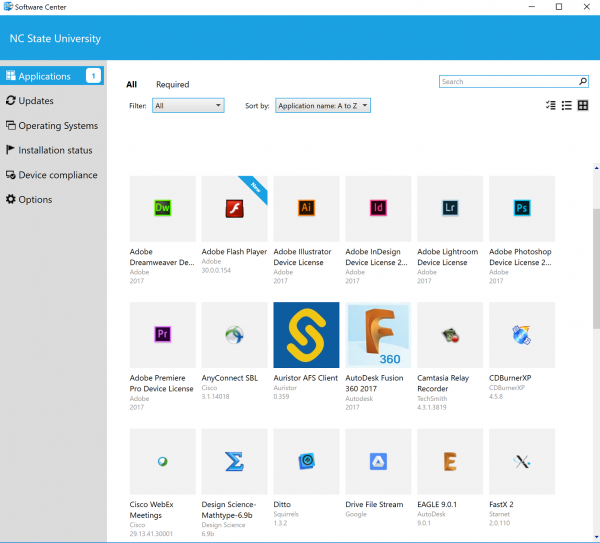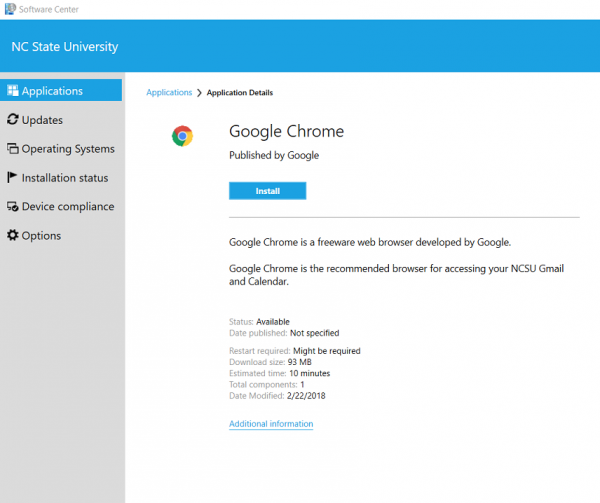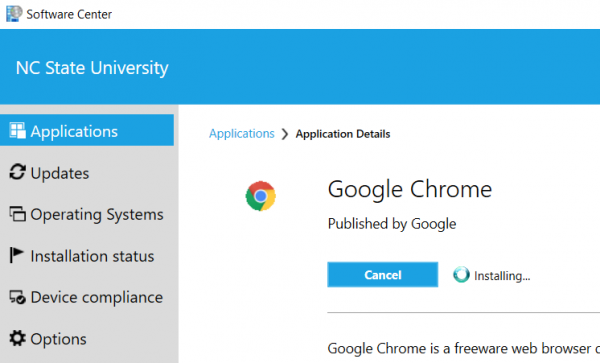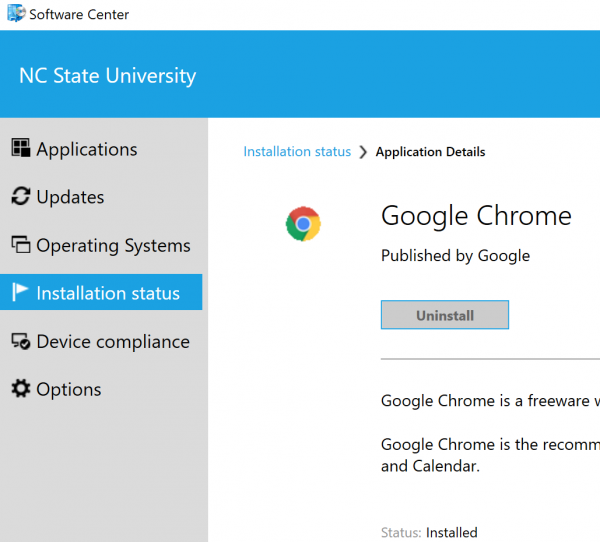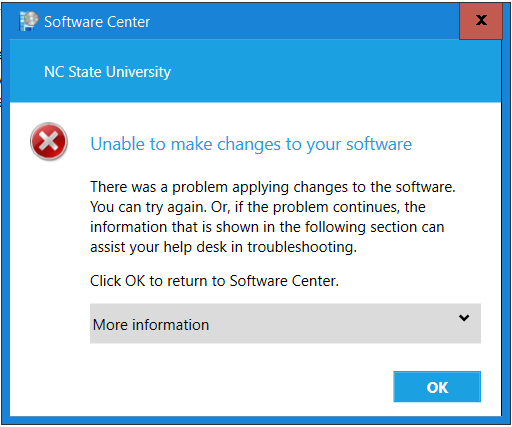Using Self-Service Advertisements
Self-Service Deployments in Microsoft’s SCCM allow us to provide users on Microsoft Windows PCs with the ability to install applications at their own convenience. In nearly all cases, these installs will be completely automated and so will require no user input or interaction aside from starting the install. This guide is intended to walk a user through the steps of locating and running Self-Service Deployments on their machine with the Software Center
NOTES:
- Administrator access is currently not required to install applications through Software Center.
- These installs should run without your input and generally will provide no notifications or dialog in order to reduce unnecessary interruption of your work.
- Please note, you will likely receive no alert or notification when an install finishes. Please be sure to confirm that your install has finished before logging out or restarting your machine.
- Deployments can be run while off-campus. However, downloads and installs will be the most reliable when your machine is connected to the on-campus network.
- This guide is intended for users of Windows 10. However, the directions should be applicable to older versions of Windows.
The Short-Short Version
- To open the Software Center, use the Search field on the Taskbar or Start Menu and search for “Software Center”, then select it.
- Alternatively, open the Start Menu, scroll down to Microsoft Endpoint Manager, then click on “Software Center”.
- Use the Search field in the top right to search for the application you require, or browse through the list of available deployments.
- After you select the application you wish to run, click the blue Install button.
- Your machine will begin downloading the installation media, and will immediately begin installing after the download is finished. Status will change as the process moves between the different stages.
- Please note, again, most, if not all, installs will run without input, notifications, or dialog.
- Once the install is finished, the Status will change to either “Installed” if successful, or “Failed” if not.
- If an install fails, click on the “Failed” status and note the error code, then contact your department or college IT support for assistance and provide that error code.
- For a more detailed look at the Software Center and deployments, as well as some additional troubleshooting, continue browsing this page.
Starting the SCCM Software Center
- To open the Software Center, use the Search field on the Taskbar or Start Menu and search for “Software Center”, then select it.
- Alternatively, open the Start Menu, scroll down to Microsoft Endpoint Manager, then click on “Software Center”.
- The image below shows the icon for the Software Center to help you identify it.
- After the Software Center finishes loading, you should see the list of applications that have been deployed to your machine. An example view of the Software Center is provided in the image below.
- Whether or not an application is deployed to your machine is the decision of your college or department computer support. Some may not be available due to licensing restrictions or other reasons. You should contact your support personnel if you have questions or a request for a particular application.
- Please also note that you are not required to install an application that is deployed to your machine. Just as some may not be available for varying reasons, others may be available that you do not need.
Using the Software Center
Search and Tabs
- See the image below for a view of the top section of the Software Center, including the Search bar.
- 1): These tabs show the different categories of deployments available to your machine:
- Applications: Available application deployments will be listed here and can be selected for install.
- Updates: Windows Updates will be listed here when they are deployed. Updates are typically mandatory and will install on a schedule set by your IT support.
- Operating Systems: Available Windows OS upgrades will be listed here. This may include feature updates to Windows 10 or upgrading older Windows OSes to Windows 10.
- Installation Status: This will show the status of Applications and Updates that are installed or currently installing. This will also show failed installations.
- Device Compliance: This shows your machine’s compliance status with security settings defined by the university and your IT support.
- Options: Please do not change any of these settings at this time.
- 2): The “Sort by” option lets you change how available deployments are listed. This defaults to “Most Recent” in the Applications tab and “Alphabetically” in other tabs.
- 3): The Search field lets you search for deployments.
- To use it, simply type in the Search field. You can type in an application or manufacturer name, or even a version number.
- The search is not case-sensitive. So “microsoft” will work the same as “Microsoft”.
Selecting and Viewing a Software deployment
- Once you have found a software you want to install, click on the icon to select it. You’ll now see the details of the application, as shown in the image below:
- Application Name: The name of the application.
- Install button: Click this to start the installation. This will update to Uninstall if the installation succeeds or Retry if it fails.
- (Note: If the Uninstall button is grey, then the application cannot be uninstalled through Software Center. Use Control Panel > Programs & Features instead.)
- Description: Additional details about the application or update will go here, if provided by the administrator who creates it.
- Status: Will start as “Available”, and will update to “Downloading”, “Installing”, and “Installed” or “Failed” during the course of the installation. If the installation fails, you can click on the status to see the specific error message returned by the installer.
- Restart required: Most deployments should not require a restart. If one does, you *should* receive a notification like the image below:

- Download size: This is the size of the downloaded install files. It is not the amount of space required for the actual install. Contact your college or departmental IT support if you are unsure if you have enough disk space.
- Estimated time: The time required to install the application. This does not include the time required to download the install files. You can safely assume 1 hour for most installations.
- Additional information: If set, this will provide a link for information and support for the specific application.
Running a Deployment
- Once you ready to start an install of a deployed software, click the blue Install button. It should change to “Cancel” and you will see “Installing” as shown in the image below:
- The status should also update to “Downloading” and “Installing” as it progresses.
- Do not log out or restart your machine while the installation is running unless prompted by the install or informed by the status.
- If an install does prompt you to restart as part of the process, please note that after Windows restarts, you must log back in for the deployment to continue.
- When the install completes, the blue button should change to Uninstall and the status should update to Installed, as shown below.
- If the Uninstall button is blue, then you can click it to uninstall the application (if necessary). If it is grey, then it cannot be uninstalled through Software Center and you must use Control Panel > Programs & Features instead.
Troubleshooting
- If an deployment fails, the status will change to “Failed” and become a link. Click the link to get the dialogue box shown below:
- From here, click on “More Information” to receive a more detailed error message. Send this error message to your IT support when you request assistance with the failed install.
Other troubleshooting
- If the Software Center is missing or gives an error when starts, contact your department or college computer support for assistance.
- Additionally, if you receive an error message during the download or install, or if an application appears to have installed properly but is missing features or licensing information, contact your department or college computer support.
- Be sure you have enough free disk space on your C drive before running a deployment. And remember you will need enough space for both the downloaded media and the installed application.
- If the Software Center starts normally but does not show any available deployments, then your machine may not yet have checked in and received its assignments. To resolve this, wait 15-30 minutes and then check again.
- If necessary, you can manually force your machine to check in (requires administrator privileges). To do so, go to Control Panel > System and Security > Configuration Manager, click on the Actions Tab, and initiate the “Application Deployment Evaluation Cycle” action.

